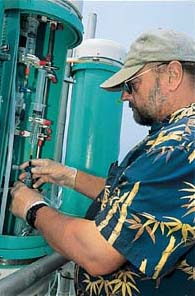 |
 |
| current issue |  |
past issues |  |
send a letter/news |  |
address update |  |
advertise |  |
about us |  |
alumni home |
Features
Air HeadsPage 3 of 4
 Instruments on Appledore Island.
Instruments on Appledore Island.
|
UNH's prominent role in the project was due in part to the university's air monitoring observatories, which sample the atmosphere day and night for some 180 chemicals. Among the most sophisticated in the world, they provide a long-term record to put into context the snapshots of air quality gathered by the study's mobile platforms. The observatories, built with AIRMAP funds (Atmospheric Investigation, Regional Modeling, Analysis and Prediction) secured with the help of Senator Judd Gregg (R-N.H.), are located atop Mt. Washington, in Moultonborough, on Appledore Island at the Isles of Shoals, and at Thompson Farm off Packers Falls Road in Durham, just a few minutes from the UNH campus.
The Thompson Farm observatory is, in fact, sometimes referred to as a NASA DC-8 without wings because its instrumentation can do the atmospheric equivalent of finding a needle in a haystack. The list of chemicals measured is a yard long and contains such beauties as trans-4-methyl-2-pentene and chlorodibromomethane.
During the campaign, Shannon Buckley, a UNH junior with a dual major in environmental conservation and international affairs, monitored the Thompson Farm instruments and collected data. If something went wrong with an instrument or if the numbers didn't look right, it was Buckley's task to try to figure it out. "Hands-on learning, I find, is the easiest way to learn, and that is exactly what I've gotten this summer," says Buckley. "People I talk to are surprised that undergraduates at UNH have these research opportunities available to them, but the undergraduate involvement at EOS has been amazing."/p>
 Alex Pszenny, UNH research associate professor of atmospheric chemistry, with instruments on Appledore Island.
Alex Pszenny, UNH research associate professor of atmospheric chemistry, with instruments on Appledore Island.
|
About 20 miles away on Appledore Island, a 63-foot concrete tower constructed during World War II to spot enemy ships was transformed into a state-of-the-art atmospheric chemistry lab with lasers, gas chromatographs, mass spectrometers and other exotic instrumentation. A long-time site for marine research, Appledore now has enhanced research capabilities as a result of the project.
Aboard the R/V Brown, the largest vessel in the NOAA fleet and the only naval vessel equipped with a state-of-the-art Doppler radar system, UNH laboratory supervisor Sallie Whitlow collected nitric acid data. The ship measured coastal pollution levels from New York City to Maine for several weeks in July.
Meanwhile, four NOAA smart balloons—so called because their double-shell design allows researchers to control their altitude—were launched by UNH's Targeted Wind Sensing program from Long Island, N.Y. The hope was they would catch an air current up the East Coast and across the Atlantic Ocean. Each balloon carried a small, one-of-a-kind ozone detection instrument developed at UNH.
While there are mind-numbing difficulties to overcome when collecting samples from a jet as it hurtles through the air, measurements made from a balloon as it lazily bobs along at five meters per second are a relative piece of cake.
Says atmospheric chemist Robert Talbot, AIRMAP and CCRC director and the principal investigator for the program, "In the jet, you pass through so much air so quickly that you really can't understand the kind of minute, complex chemistry that could be occurring in that location."
Page: < Prev 1 2 3 4 Next >Easy to print version

